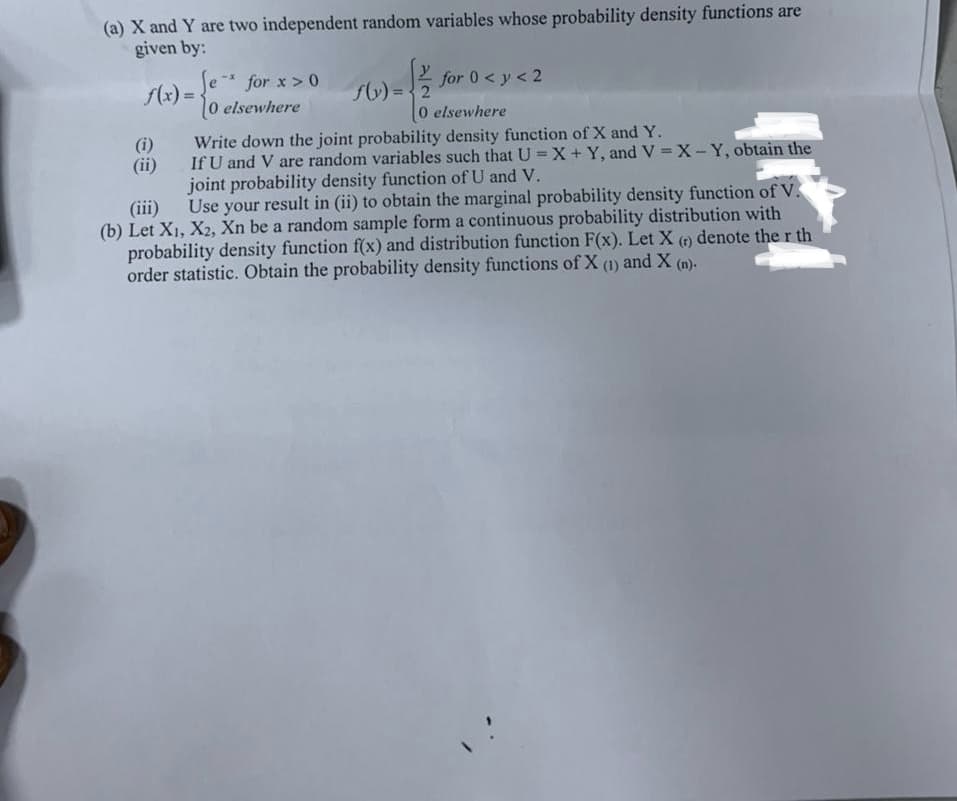(a) X and Y are two independent random variables whose probability density functions are given by: f(x) = for x >0 f6) = { 2 for 0< y < 2 %3D 0 elsewhere 0 elsewhere Write down the joint probability density function of X and Y. If U and V are random variables such that U =X+Y, and V =X- Y, obtain the joint probability density function of U and V. Use (i) (ii) result in (ii) to obtain the marginal probability density function of V. (iii) (b) Let X1, X2, Xn be a random sample form a continuous probability distribution with probability density function f(x) and distribution function F(x). Let X (2) denote the r th order statistic. Obtain the probability density functions of X (1) and X (n). your
(a) X and Y are two independent random variables whose probability density functions are given by: f(x) = for x >0 f6) = { 2 for 0< y < 2 %3D 0 elsewhere 0 elsewhere Write down the joint probability density function of X and Y. If U and V are random variables such that U =X+Y, and V =X- Y, obtain the joint probability density function of U and V. Use (i) (ii) result in (ii) to obtain the marginal probability density function of V. (iii) (b) Let X1, X2, Xn be a random sample form a continuous probability distribution with probability density function f(x) and distribution function F(x). Let X (2) denote the r th order statistic. Obtain the probability density functions of X (1) and X (n). your
A First Course in Probability (10th Edition)
10th Edition
ISBN:9780134753119
Author:Sheldon Ross
Publisher:Sheldon Ross
Chapter1: Combinatorial Analysis
Section: Chapter Questions
Problem 1.1P: a. How many different 7-place license plates are possible if the first 2 places are for letters and...
Related questions
Topic Video
Question
Hello, Help me please

Transcribed Image Text:(a) X and Y are two independent random variables whose probability density functions are
given by:
Je for x> 0
0 elsewhere
for 0< y< 2
= 5
0 elsewhere
(x) =
f) = { 2
%3!
Write down the joint probability density function of X and Y.
If U and V are random variables such that U = X+ Y, and V = X- Y, obtain the
joint probability density function of U and V.
Use your result in (ii) to obtain the marginal probability density function of V.
(i)
(ii)
(ii)
(b) Let X1, X2, Xn be a random sample form a continuous probability distribution with
probability density function f(x) and distribution function F(x). Let X (e) denote the r th
order statistic. Obtain the probability density functions of X (1) and X (n).
Expert Solution
This question has been solved!
Explore an expertly crafted, step-by-step solution for a thorough understanding of key concepts.
This is a popular solution!
Trending now
This is a popular solution!
Step by step
Solved in 2 steps with 2 images

Knowledge Booster
Learn more about
Need a deep-dive on the concept behind this application? Look no further. Learn more about this topic, probability and related others by exploring similar questions and additional content below.Recommended textbooks for you

A First Course in Probability (10th Edition)
Probability
ISBN:
9780134753119
Author:
Sheldon Ross
Publisher:
PEARSON


A First Course in Probability (10th Edition)
Probability
ISBN:
9780134753119
Author:
Sheldon Ross
Publisher:
PEARSON
